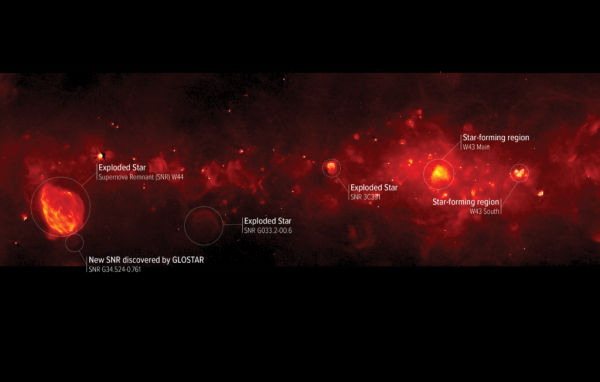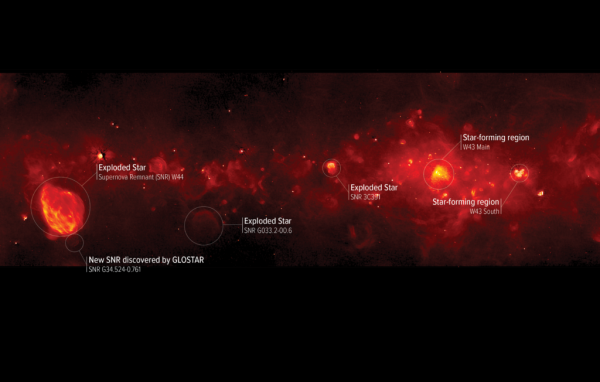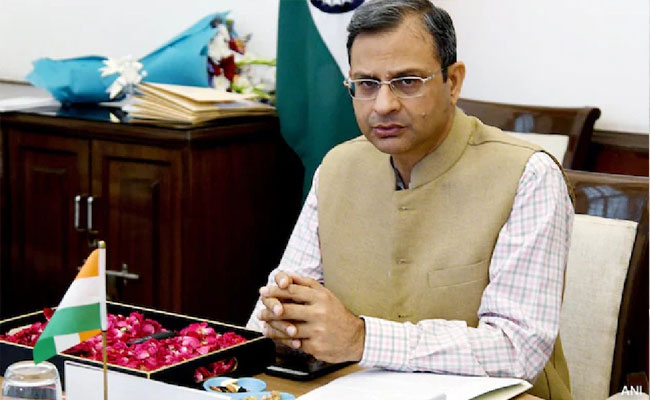Bengaluru, July 23: An international team of astronomers has carried out an extensive new survey of the Milky Way, revealing previously unseen signatures with unprecedented sensitivity and details that hint at how stars form and die, complex processes that have fascinated researchers for centuries.
The results were published in a series of papers in 'Astronomy & Astrophysics' by the team, which includes scientists from the Indian Institute of Science (IISc) and the Indian Institute of Space Science and Technology (IIST).

(Photo: Brunthaler et al., Sophia Dagnello, NRAO/AUI/NSF)GLOSTAR image, using data from both the VLA and the Effelsberg radio telescope, shows a segment of the Milky Way's disk, revealing previously unseen tracers of massive star formation. Some of these features are identified in this version of the image.
The data for the survey, which spanned a large part of the Milky Way, was gathered using two powerful radio telescopes: the Karl G Jansky Very Large Array (VLA) at the National Radio Astronomy Observatory, USA, and theEffelsberg100-m radio telescope operated by the Max Planck Institute for Radio Astronomy Germany, as part of the GLOSTAR (Global View on Star formation in the Milky Way) project.
Nirupam Roy, Assistant Professor at the Department of Physics and Rohit Dokara, his former undergraduate student from IISc, as well as Jagadheep D Pandian, Associate Professor at the Department of Earth and Space Sciences in IIST are among the Indian scientists who are part of the GLOSTAR project, Bengaluru-based IISc said in a statement on Friday.
Dokara, now a PhD student at MPIfR, is the first author on one of the papers that reports the detection of new supernova remnants (SNRs) structures born from the explosive death of massive stars in our galaxy.
Previous surveys have detected only about one-third of the expected number of SNRs in the Milky Way (which is nearly 1000), according to the statement.
The GLOSTAR team has now discovered 80 new SNR candidates in the VLA data alone,with more expected to be identified from the combined Effelsberg and VLA data.
They were also able to confirm the presence of 77 previously discovered SNR candidates and reclassify a few that were misidentified.
This is impressive, considering that the northern telescopes utilised by GLOSTAR are able to see only half of the inner regions of the Milky Way, it said.
"This is an important step to solve this long-standing mystery of the missing supernova remnants," said Dokara.
The researchers were also able to detect other traces of star formation.
One of them, for example, is radio emission from methanol molecules in a nearby large star-forming complex 'Cygnus X.'
These are typically emitted from massive stars in very early stages of formation.
The team was also able to detect dense pockets of ionised hydrogen, another tell-tale sign of the presence of massive young stars.
Young stars are usually surrounded by thick clouds of dust and gas.
"Because visible light gets absorbed in this dense cloud around stars, most of the optical telescopes dont reveal much.
What people look for, instead, are radio emissions," explained Roy, who has previously worked at both NRAO and MPIfR.
"Since the GLOSTAR survey detects a wide range of radio emission such as that from methanol molecules to ionised hydrogen, it is able to probe the formation of massive stars from very early to relatively late stages, which is important to get a complete picture of star formation in the Milky Way," added Pandian, who has also previously worked at MPIfR.
The Effelsberg radio telescope is a single large dish spanning 100 m in diameter, capable of detecting large-scale structures, whereas the VLA is a collection of small antennas which work together as an interferometer to capture the details at high resolution.
The data pooled from both telescopes helped the researchers paint a more comprehensive picture of different astrophysical objects in the region.
"This clearly demonstrates that the Effelsberg telescope is still very crucial, even after 50 years of operation," said Andreas Brunthaler of MPIfR, project leader and first author of the survey's overview paper.
Karl Menten, the Director of MPIfR, who initiated GLOSTAR, added: "Its great to see the beautiful science resulting from two of our favourite radio telescopes joining forces."
Both Pandian and Roy currently maintain Max Planck-India Partner Groups with Menten to continue the close collaboration and, in particular, to expand the scope of the GLOSTAR project.
Other members of the research team include scientists from MPIfR and NRAO, and collaborators from institutions in the UK, South Africa, Mexico, France and Australia.
With observations and analysis ongoing, more results are expected to be published over time, it was stated.
New extensive survey of #MilkyWay using powerful radio telescopes reveals previously unseen details that hint at how stars form and die. The team includes researchers from IISc, @IIST_Trivandrum, MPIfR, @TheNRAO & other collaborators.https://t.co/URLPyRrckg pic.twitter.com/plwYKLiPr2
— IISc Bangalore (@iiscbangalore) July 23, 2021
Let the Truth be known. If you read VB and like VB, please be a VB Supporter and Help us deliver the Truth to one and all.
Amritsar (PTI): Former president Ram Nath Kovind on Friday said that with digital transformation, economic reforms and a strong focus on the ease of doing business, India is moving towards becoming a global economic powerhouse.
He was speaking after inaugurating the 19th edition of the Punjab International Trade Expo (PITEX) in Amritsar.
The former president said that this 19th edition of PITEX is being organised at a time when India is recognised as one of the fastest-growing large economies in the world.
Speaking at the inaugural ceremony of the event organised by the PHD Chamber of Commerce and Industry (PHDCCI) the former president, while referring to Punjab, said the state is a living example of courage, sacrifice and enterprise.
"The spiritual light of Sri Harmandir Sahib (Golden Temple) inspires peace and humanity across the world. The heritage of Punjab is deep and inspiring," Kovind said, according to a statement issued by the PITEX.
The former president congratulated the PHDCCI for hosting the 19th edition of PITEX and suggested that the chamber should expand PITEX outside Punjab.
He proposed that a similar event should also be held in New Delhi.


_vb_69.jpeg)


